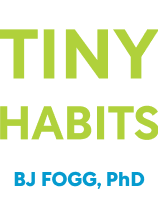

This article is an excerpt from the Shortform book guide to "Tiny Habits" by BJ Fogg. Shortform has the world's best summaries and analyses of books you should be reading.
Like this article? Sign up for a free trial here .
What is the Tiny Habits Method? How do you put together a Tiny Habits recipe?
The Tiny Habits Method consists of putting together daily, ten-second habits that set you up to accomplish big habits later. The Tiny Habits recipe goes something like this: “After (blank)…I will (blank)… And I will celebrate by (blank).” It’s an easy recipe to follow and can lead to big changes.
Continue on to learn how you can integrate the Tiny Habits Method into your life.
Tiny Habits Method
Why should we work with the Tiny Habits Method?
Tiny Habits are:
- Low on time demand. Many of us have full lives and little time to fit in new habits. The idea of a daily ten-second habit is less daunting (and more realistic) than a half-hour one. The typical Tiny Habit takes under 30 seconds. You can do many of the habits suggested in the book in under five seconds. This means you can fit them in easily, no matter how busy you are.
- Effective immediately. A well-designed Tiny Habit is one you can start right now.
- Psychologically safe.
- Wobbles—even faceplants—are part of the process. Babies fall all the time when they’re learning to walk, but it doesn’t hurt much because they’re already close to the ground. If you don’t succeed with your new habit the first time, you’re not a failure: Just stand up, tweak something, and try again.
- Tiny Habits are private. The changes are so small that nobody else needs to know. This means you can operate without any pressure, as well as avoiding You also avoid potential sabotage attempts by others.
- It’s impossible to fail. It’s all an experiment—so if it’s not working, just fiddle with the controls and try again.
- The self-compassion that you practice through Tiny Habits ripples out into your general approach to life.
- Set up for growth. Tiny Habits generate momentum that, over time, helps you accomplish bigger and bigger tasks. You can create an ecosystem of carefully chosen small new habits that together have a big impact.
- Willpower-independent. Motivation, or willpower, isn’t reliable. It comes and goes in waves, so we can’t depend on it to build consistent habits. In Tiny Habits, the target habits are so small that we need very little motivation to do them.
- Fun. The essence of Tiny Habits is play and experimentation. There’s no grim “do or die” mentality—you deliberately focus on activities that you want to do. And all Tiny Habits sequences include an instant celebration, which teaches your brain to do the behavior again.
- Tried and tested. Throughout the book, Fogg gives examples of his own experience creating Tiny Habits. He also includes many anecdotes about the experiences of others who’ve attended his Behavior Design boot camps and online courses.
The Structure of a Tiny Habit
The structure of a Tiny Habit is like a sandwich, with the behavior in the middle. A good mnemonic is ABC:
> 1. Anchor: The point in your regular routine that your Tiny Habit will be tied to
> 2. Tiny Behavior: The new habit in simple form
> 3. Immediate Celebration: Some brief but meaningful way to create positive emotions after you’ve executed your Tiny Habit successfully.
Let’s say you want to introduce the habit of going for a walk after your morning coffee. Your Anchor might be rinsing the cup and setting it down to dry. Your Tiny Behavior might be putting your walking shoes on. And your immediate Celebration might be punching the air and shouting “Yes!”
“Recipes” for the Tiny Habits Method
To capture the experimental feel of Tiny Habits, Fogg translates this sequence into a “recipe.”
1. After… [Anchor]
2. I will… [Tiny Behavior]
3. To celebrate, I will … [Celebration]
Here are some example recipes:
* After I put my coffee cup in the dish drainer, I will put my walking shoes on. Then I will punch the air and shout “Yes!”
* After I brush my teeth, I will floss one tooth. Then I will smile.
If you like, you can write your habit recipes on physical recipe cards for quick reference.
As with any recipe, if it doesn’t turn out well, experiment with the ingredients and proportions and try again.

———End of Preview———
Like what you just read? Read the rest of the world's best book summary and analysis of BJ Fogg's "Tiny Habits" at Shortform .
Here's what you'll find in our full Tiny Habits summary :
- How you can successfully create new habits that stick
- Why you don't need motivation, just science
- Why even flossing one tooth should be considered a victory






